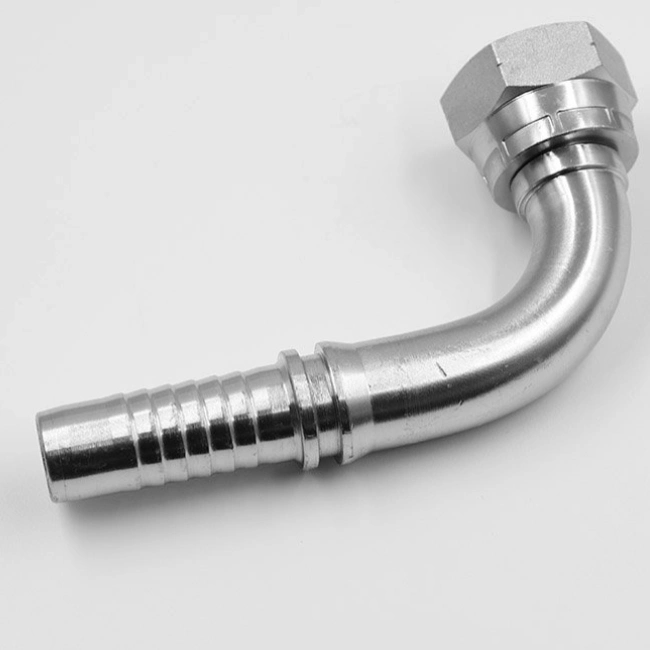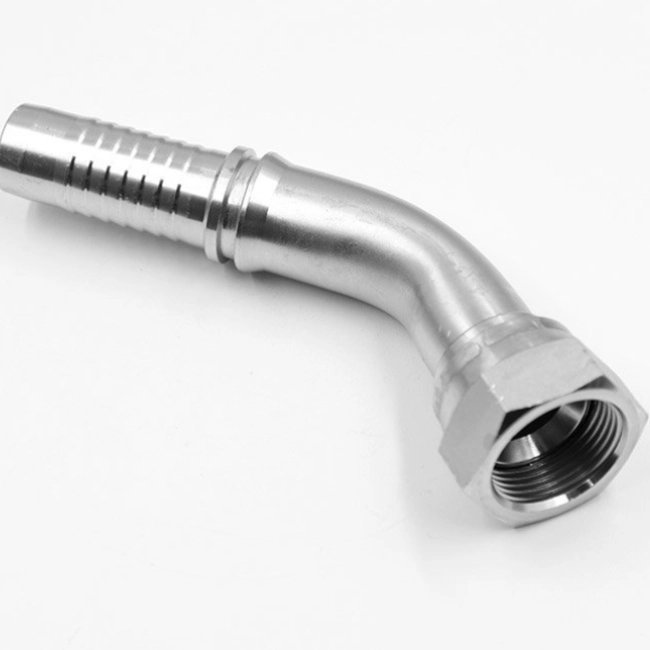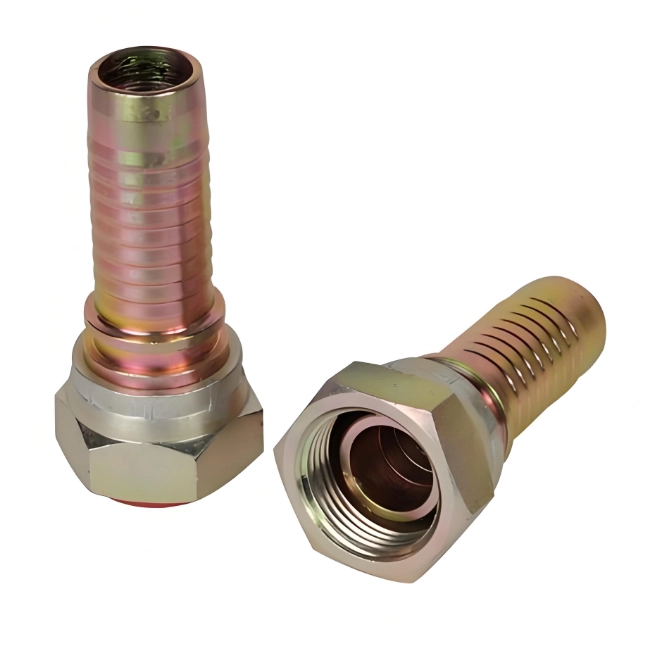JIC 37° flare connection fittings (in accordance with SAE J514) are very common connections in hydraulic systems, known for their reliability and reusability. However, problems are often encountered during use. The following is a list of common problems and solutions for JIC 37° flare connection fittings:
JIC 37° flare connection fittings leakage problems
Possible causes.
Damage to the taper:Scratches, dents, wear, corrosion or deformation of the 37° taper inside the fitting body or nut.
Failed tube end flare: 37° flare at tube end is not round, cracked, scratched, incorrectly sized (too large or too small), surface roughness is too large.
Improper assembly.
Insufficient tightening:The specified torque is not reached, and the taper surface is not sufficiently adhered to form a metal seal.
Over-tightening: resulting in deformation and collapse of the taper surface, cracking of the tube end flare or damage to the threads.
Pipe end not aligned: the installation of the pipeline is not straight, forced tightening leads to one-sided contact or scratches on the taper surface.
Foreign matter contamination: there are dust, oil, metal chips, sealant fragments and other foreign matter between the taper surface or flare end surface.
Worn or damaged threads:Damage to the threads of the nut or fitting body that prevents proper tightening.
Material fatigue or cold flow:After long-term use or repeated disassembly, fatigue or plastic deformation (cold flow) of the metal at the flare end of the tube, resulting in seal failure.
Pipe vibration:Excessive vibration causes the fitting to loosen gradually.
Solution.
Inspect and clean:Disassemble the fitting and thoroughly clean all tapered surfaces, flared ends and threads. Make sure there are no foreign objects.
Carefully inspect the taper and flare.
Use a magnifying glass to inspect the fitting body and the inner taper of the nut for damage. Minor damage can be removed by very careful polishing of the circumference with very fine sandpaper (e.g., 800 grit or more) or an oil stone, but serious damage must be replaced.
Check that the tube end flare is rounded, free of cracks and deep scratches. Failed flares must be cut out and rebuilt.
Correct Assembly.
Ensure that the tubing is cut flush and deburred.
Use a special flaring tool to make a 37° flare according to specifications.
Manually screw the nut into the fitting body several times to ensure proper alignment.
Use a torque wrench to tighten to fitting specifications and manufacturer’s recommendations. Avoid under or over tightening. The general rule is to tighten to contact and then add 1/6 to 1/4 turn (refer to standards or manuals for specifics).
Ensure that the lines are substantially straight when connected and avoid forced bends.
Replace damaged parts:If the taper is severely damaged, flaring is unacceptable, threads are damaged, or tube ends are fatigued, replace the appropriate fitting body, nut, or entire section of tubing.
Check for system vibration: Add clamp support for excessively vibrating lines to isolate the source of vibration.
Loose or vibrating JIC 37° flare connection fittings
Possible Cause.
Failure to meet specified torque during installation.
Excessive system vibration.
Inadequate line support, resulting in additional stress on the fitting.
Material fatigue or cold flow.
Solution.
Retorque to specification torque.
Check and reinforce line support, add pipe clamps, and reduce overhang length.
Analyze and resolve sources of vibration (e.g., pump, motor imbalance).
If fatigue is the cause, replace affected parts.
JIC 37° flare connection fittings with damaged threads (slipped threads, messed up threads)
Possible cause.
Forced screwing into unaligned threads.
Use of mismatched fittings (e.g. metric, BSP by mistake).
Use of improper tools (e.g., slipped adjustable wrench) or over-tightening.
Rusted or contaminated threads.
Solution.
Do not force screw in! Manual screw-in should be smooth. If resistance is encountered, quit checking the threads for cleanliness, alignment and matching specifications.
Be sure to use the correct size JIC fitting (usually UN/UNF threads).
Use a properly sized open-end wrench or socket wrench in good condition.
Clean threads and remove burrs or rust (proceed with caution).
Replace damaged nuts or connector bodies.
JIC 37° Flare Connection Fittings Tube End Flare Cracking Problems
Possible Cause.
Over tightening.
Improper use or wear of flaring tool.
Poor quality, defective or too hard/brittle tubing.
Insufficient deburring or chamfering of the tube end before flaring.
Excessive flaring.
Solution.
Cut off the cracked flare.
Ensure that the tube ends are cut flush
JIC 37° flare connection fittings are difficult to remove
Possible cause.
Deformation or “seizure” of the threads due to over-tightening.
Corrosion (especially galvanic corrosion of dissimilar metals in contact).
Prolonged high temperatures leading to material adhesion.
Solution.
Use a suitable tool (to avoid slipping and damaging the corners of the nut).
Try using a penetrating lubricant (e.g. WD-40) for a period of time.
Carefully heat the joint body (be safe and avoid igniting the hydraulic fluid).
In extreme cases, it may be necessary to cut the tube or destroy the nut (be safe, the system must be completely relieved of pressure!) .
JIC 37° flare connection fittings with mixed sizes
Possible causes.
Mistaking metric fittings, BSPP (G thread), BSPT (R thread), and NPT fittings for JICs. Although they can sometimes be barely screwed in, the taper is different and will inevitably lead to leaks.
Unfamiliar with JIC specifications (e.g. -4, -6, -8, etc.) corresponding to the pipe OD and thread size.
Solution.
Clear identification:JIC fittings have a distinct hex or dodecagonal angle on the nut with a 37° taper. Threads are usually UNF (fine thread) or UN (coarse thread). bspp is a parallel thread + flat gasket/seal, bspt/npt is a tapered thread.
Use of gauges:Use thread gauges and taper gauges for identification.
Check standards: Familiarize yourself with SAE J514 standards for Dash Size (e.g. -4, -6, -8) corresponding to pipe OD and thread size.
Use only matching fittings!
Problems with material compatibility of JIC 37° flare connection fittings
Possible causes.
Incompatibility of the fitting material (e.g. carbon steel) with the conveying medium (e.g. certain aggressive chemicals, seawater), resulting in corrosion leakage.
Electrochemical corrosion occurs when different metals (e.g. steel fittings with aluminum blocks) come into contact.
Solution.
According to the system to transport the media to select the appropriate joint material (such as stainless steel, brass).
Where galvanic corrosion may occur, use insulating gaskets or select compatible metals.
Preventive Recommendations Summary
- Use high-quality components: Select fittings, tubes, and nuts that meet SAE standards.
- Standardize practices.
Cut tubing accurately and deburr and chamfer thoroughly.
Use specialized, well-maintained 37° flaring tools and operate them properly.
Clean! Clean! Clean! Ensure that all sealing surfaces (taper surfaces, flare end surfaces) and threads are absolutely clean and free of contamination.
Align the thread manually and screw in smoothly.
Use a torque wrench to tighten to specification torque (refer to manufacturer’s manual or SAE standards). Remember that it is a misconception that it is better to tighten than to loosen. 3! - Properly support lines: Avoid bending stresses or excessive vibration on fittings. 4.
- Periodic Inspection: Check fittings for leaks, looseness, and signs of corrosion during system maintenance. 5. Proper Identification: Ensure fittings are properly identified.
- correct identification: make sure that the fittings used are indeed JIC 37° and that they are distinguished from other types of fittings.
- Consider the material: Select the appropriate material according to the application environment (medium, temperature, pressure).
Conclusion:
By understanding these issues and strictly following proper installation and maintenance protocols, you can minimize the likelihood of JIC 37° flare connection fittings failing and ensure the reliable operation of your hydraulic system. Remember, hydraulic system safety comes first, always make sure the system is fully pressurized before any operation! If you have further questions about JIC 37° flare connection fittings please ask our technical engineer who will answer them for you free of charge.
Related accessories:
jic fitting vs. an fitting purchasing decision guide





